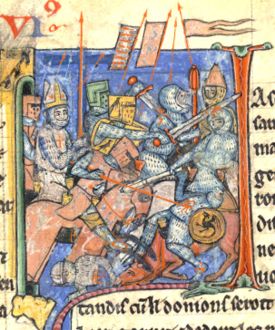
Adhemar of Le Puy
Encyclopedia

First Crusade
The First Crusade was a military expedition by Western Christianity to regain the Holy Lands taken in the Muslim conquest of the Levant, ultimately resulting in the recapture of Jerusalem...
, was bishop of Puy-en-Velay from before 1087. At the Council of Clermont
Council of Clermont
The Council of Clermont was a mixed synod of ecclesiastics and laymen of the Catholic Church, which was held from November 18 to November 28, 1095 at Clermont, France...
in 1095, Adhemar showed great zeal for the crusade (there is evidence Urban II had conferred with Adhemar before the council) and having been named apostolic legate and appointed to lead the crusade by Pope Urban II
Pope Urban II
Pope Urban II , born Otho de Lagery , was Pope from 12 March 1088 until his death on July 29 1099...
, he accompanied Raymond IV
Raymond IV of Toulouse
Raymond IV of Toulouse , sometimes called Raymond of St Gilles, was Count of Toulouse, Duke of Narbonne, and Margrave of Provence and one of the leaders of the First Crusade. He was a son of Pons of Toulouse and Almodis de La Marche...
, Count of Toulouse, to the east. Whilst Raymond and the other leaders often quarrelled with each other over the leadership of the crusade, Adhemar was always recognized as the spiritual leader of the crusade.
Adhemar negotiated with Alexius I Comnenus at Constantinople
Constantinople
Constantinople was the capital of the Roman, Eastern Roman, Byzantine, Latin, and Ottoman Empires. Throughout most of the Middle Ages, Constantinople was Europe's largest and wealthiest city.-Names:...
, reestablished at Nicaea
Iznik
İznik is a city in Turkey which is primarily known as the site of the First and Second Councils of Nicaea, the first and seventh Ecumenical councils in the early history of the Church, the Nicene Creed, and as the capital city of the Empire of Nicaea...
some discipline among the crusaders, fought a crucial role at the Battle of Dorylaeum and was largely responsible for sustaining morale during the siege of Antioch
Siege of Antioch
The Siege of Antioch took place during the First Crusade in 1097 and 1098. The first siege, by the crusaders against the Muslim city, lasted from October 21, 1097, to June 2, 1098. The second siege, against the crusaders who had occupied it, lasted from June 7 to June 28, 1098.-Background:Antioch...
through various religious rites including fasting and special observances of holy days. After the capture of the city
Antioch
Antioch on the Orontes was an ancient city on the eastern side of the Orontes River. It is near the modern city of Antakya, Turkey.Founded near the end of the 4th century BC by Seleucus I Nicator, one of Alexander the Great's generals, Antioch eventually rivaled Alexandria as the chief city of the...
in June, 1098, and the subsequent siege led by Kerbogha
Kerbogha
Kerbogha was Atabeg of Mosul during the First Crusade and was renowned as a soldier. He was a Turk who owed his success to his military talent. In 1098, when he heard that the Crusaders had besieged Antioch, he gathered his troops and marched to relieve the city. By the time he arrived, around...
, Adhemar organized a procession through the streets, and had the gates locked so that the Crusaders, many of whom had begun to panic, would be unable to desert the city. He was extremely skeptical of Peter Bartholomew
Peter Bartholomew
Peter Bartholomew was a soldier and mystic from France who was part of the First Crusade.In December, 1097, during the siege of Antioch, Peter began to have visions, mostly of St. Andrew. Peter claimed St. Andrew took him to the Church of St. Peter, inside Antioch, and showed him where the relic...
's discovery in Antioch of the Holy Lance
Holy Lance
The Holy Lance is the name given to the lance that pierced Jesus' side as he hung on the cross in John's account of the Crucifixion.-Biblical references:The lance is mentioned only in the Gospel of John and not in any of the...
, especially because he knew such a relic already existed in Constantinople; however, he was willing to let the Crusader army believe it was real if it raised their morale.
When Kerbogha was defeated, Adhemar organized a council in an attempt to settle the leadership disputes, but he died on 1 August 1098, probably of typhus
Typhus
Epidemic typhus is a form of typhus so named because the disease often causes epidemics following wars and natural disasters...
. The disputes among the higher nobles went unsolved, and the march to Jerusalem was delayed for months. However, the lower-class foot soldiers continued to think of Adhemar as a leader; some of them claimed to have been visited by his ghost during the siege of Jerusalem
Siege of Jerusalem (1099)
The Siege of Jerusalem took place from June 7 to July 15, 1099 during the First Crusade. The Crusaders stormed and captured the city from Fatimid Egypt.-Background:...
, and reported that Adhemar instructed them to hold another procession around the walls. This was done, and Jerusalem was taken by the Crusaders in 1099.
External links
- Medieval Sourcebook: Speech by Urban II at Council of Clermont, 1095 (Five versions of the Speech)

